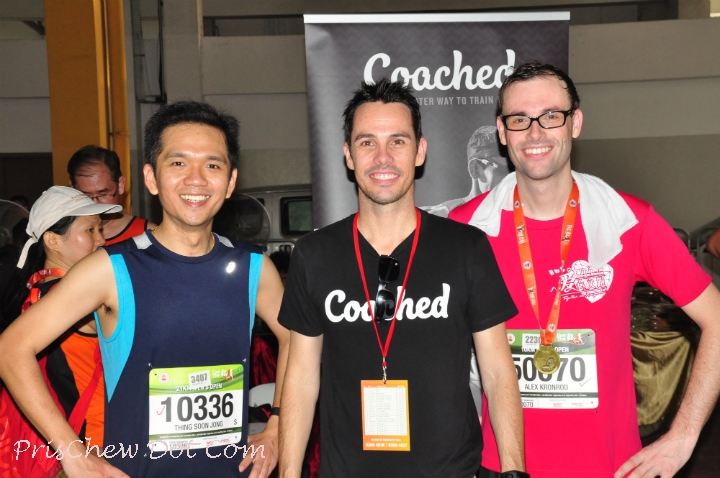Many distance runners are training too hard, too often.
This is according to Ben Pulham, 35, running coach and founder of Coached, a boutique fitness company. Said Ben, “Based on what we see at our lab, many people have a poor ability to clear lactate – this means that they are running their easy sessions above an intensity that fully develops their aerobic system but because they are too tired from doing all the fast stuff, their hard sessions are too slow to fully develop their anaerobic system.”

Coached’s Ben Pulham (centre) thinks that runners are training too hard.
He continued, “This means that if you are too fatigued and tired from your easy sessions, you cannot execute the high intensity stuff at a high enough intensity to really benefit and train the anaerobic system.”
Coached’s heart rate zones
In terms of the five heart rate zones below, that Coached uses,
- Easy (Zone 1)
- Steady (Zone 2)
- Moderately Hard (Zone 3)
- Hard (Zone 4)
- Very Hard (Zone 5),
Ben feels that most people are training in Zone 3, the Moderately Hard zone for the bulk of their training sessions. He said, “If you do all of your runs in the Moderately Hard zone, that is not good. Do your easy sessions harder. Instead, the Moderately Hard zone is good for tempo training, that is, 30-40 minutes of constant tempo running or as shorter intervals.”

Runners should train at lower intensities.
This is also a possible reason why many runners get injured, according to Ben. He said, “It’s a common reason that because people run too hard and overtrain, they get injured and sick. The intensity level determines the benefit of the session. So pay close attention to what intensity you are running at and how much you are doing at each intensity level.”
Heart rate training suits injury prone runners
He added, “Running is an impact sport so aches and pains are normal; I don’t have a perfect solution for running injury free, but heart rate intensity training is a good solution for those who are injury prone and having problems, as it keeps a check on your efforts and if you are working hard enough to get the physiological benefits, but not so hard that you are bordering on exhaustion.”
Importance of training at the right intensity
To further highlight the importance of training at the right heart rate intensity, Ben is putting up a series of articles on the Coached blog. The first article, which was posted earlier this week, had introduced runners to the basics of heart rate intensity training.
Said Ben, “And in future articles, I will talk about the training zones that we use on our site and the benefits of each of these. I will also do a series on the pros and cons of running by pace, feel and heart rate.”
He added, “For instance, the pros of running by heart rate varies, as compared to running by pace or feel. But the main downsides are that heart rate monitors are so sensitive and as such, not always reliable.”
Accuracy of heart rate monitors

Initially it may be hard to adjust to train by heart rate.
According to Ben, a sure way to know that something is wrong with your heart rate monitor, is that it stays at a constant heart rate for long periods of time. Explained the coach, “If you hit a hill or head wind, your heart rate is bound to change. If it does not change, your heart rate monitor is not accurate. Sometimes it can take up to 10-15 seconds to change; the wrist based ones are usually the ones that have a lag.”
He added, “In the first few weeks it can be hard to train by heart rate, but as you watch your heart rate monitor and get used to it, you start to see what are the things that can affect your readings. For example stress causes the heart rate to rise. Hot weather also increases the heart rate. Over time you will start to know if the variations in heart rate readings are a result of stress, whether it is a strange reading, or simply lag.”
Determining Heart Rate Zones
The most accurate way to determine your heart rate zones, to begin training by heart rate, is by going for a Coached lactate test. But for those who may not have the time to head down to the lab, Ben recommends the 180 formula developed by Phil Maffetone, to determine your maximum aerobic heart rate zone.
A consultant to sports teams and corporations, Maffetone is a specialist in coaching, nutrition and exercise in the United States since the 1980s.
And according to the Maffetone 180 formula, you would subtract your age from 180 and modify this number depending on the four scenarios below:
- Recovering from an illness or are on regular medication (subtract 10)
- Injured (subtract 5)
- Training consistently (No change to the number)
- Training consistently for more than two years and have made progress in training (add 5)
Said Ben “Use this as a ceiling for your Easy zone. For the Steady zone, add 15 to the reading. For the Moderately Hard zone, add 10 and for the Hard zone, add 5. Anything above that is your Very Hard zone.”
He added, “There are tons of formulas but we picked thus one because we needed a simple formula. We took the basic heart rate formulas and cross checked the results against our clients’ lactate results to find which one came the closest to their lactate readings.”
Alternatively, you could also do a 30 minute hard run and record your heart rate for the last 20 minutes, taking the average of this reading as your lactate threshold heart rate and work out the various heart rate zone percentages from there.

Runners should try and record an average heart rate within their target zones.
Training with your zones
While Ben recommends staying in your target heart rate zones for as long as possible, but he adds that it is okay if your heart rate exceeds the zone by a fraction. He explained, “A bit of give and take is okay, but the key message is that you should not spend too much time above the stated zone; the actual heart rate can go up and down, but do not hold it above the zone for too long.”
He added, “The average heart rate for the session should be in the low to mid end of the zone. If your zone is 150-165 then your average heart rate should be about 155… unless I say otherwise in your training programme.”
Click here to read more about intensity training and other articles on Ben’s Coached Blog.
If you are interested to join Coached, you can get a discount with prischew.com.
Just key in the discount code pris and you will get 20 per cent off your membership fees for the first three months.

Leave a Comment